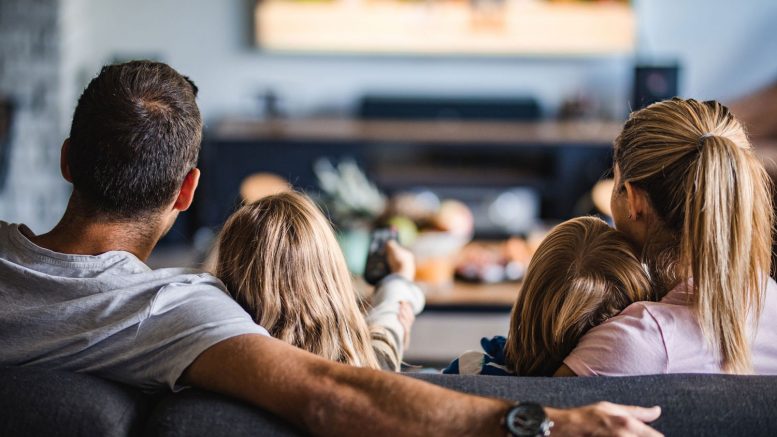Evenings, when I was a child, were spent playing through the twilight hours every day. With everyone home from work by 5 o’clock, uncles, aunts, parents, and grandparents, all would gather to sip tea on the porch, chatting and gossiping. When the evening turned darker, we would hope that the adults were having a good enough time to let us play some more. On some lucky days, they would sit around until it was firmly dark, and that’s when we were happy as puppies – having played through the evening, we also got to snuggle up tired with the grown-ups, comforted despite the dark, by their boring conversation.
Today we watch a lot of TV.
It’s just the times and technology we live in. Movie nights have replaced evenings with chai for my urban household. Gossiping with my ten-year-old about the characters of his current OTT show is me going with the flow, discovering parenting in the age we live. But, being a media student and those forced sessions of media analysis and literary criticism kicked in, and I decided to embrace this TV-watching world as an opportunity to share how media works. We watch movies and shows together, pause at moments that call for commentary, or that may seem to give the wrong ideas – a well-placed “As if!!” by me interrupts fantasy and brings in reality when there are hyperbolic exaggerations that could be misconstrued as real life. We research new movies, video games, and shows and discuss whether they would be suitable. We understand camera tricks and what is real or scripted. It’s something that I now share with my child, aside from the usual fights about too much screen time.
Here’s how I have evolved my evaluation parameters of what to watch.
- The context or setting
Where the show is set is a good first step. Is it a cultural context that aligns with your values, or offers an exposure that you think is great? For example, the movie Chillar Party resonates well with the apartment lives of children in metropolitan cities of India, while KD (Karuppudurai) is set in village life of India. Contexts provide a rich basis for choosing what is great to watch, with the many global and regional shows to pick from. Other examples – A series of unfortunate events is set slightly on the macabre, and Lost in Space opens up fantastic visuals of space scapes, but depending on your child’s imagination, these could also be a little scary. The context is something that the viewer sees themselves in, that’s what makes the show interesting to them, so whether it’s a school, a neighborhood, a different country, Jurassic Park or a zombie apocalypse, this is one aspect to think about.
- What’s the general theme, and how complex is the treatment?
The theme of the OTT show or movie is different from the context or setting. The theme relates to the storyline – is it about friendship, or family, is it about the personal discovery of oneself, or struggle against society. Themes are very important to evaluate, based on the level that your child is able to understand, rationalise and discuss with you. This brings me to complexity – a theme as simple as friendship can have deeply complex nuances which can confuse children. For example, Family Reunion has the context pretty clear, a family that moves to live together again. It makes no secret of them being deeply religious, but then swings into complex philosophical themes of sexuality. Similarly, many superhero shows start out with simple themes of right and wrong and then move into the social spheres that involve complexities around dating, which are better suited for older teens. It’s important also to make sure that the themes are positive – children will face life, and as much positivity as you can fill them with in childhood will hold them in good stead.
- What is the kind of language and humour?
Humour and language can be varied, and introduce new concepts and vocabulary to children. While slapstick is always fun for kids, is the line drawn at the edge of it becoming violent or bordering on obscene and inappropriate? If the humour is clever and literary, is it also clear and clean, and not embedded with coded messages? Of course bad language is a red flag. I remember how angry I was with the movie Work It, a studious young girl decides to form her own dance team to add ‘personality’ to her college applications. It’s all good, messages of aspiration, determination, and friendship, until at the end their competing team is disqualified because one of their male dancers is ‘too excited’. Cringe. Not only is this unnecessary, but also wrong to make fun of, at an age when boys are as easily embarrassed as girls. It just ruined the whole positivity of the movie.
- Characters and stereotypes
You never really know this one until after you start to watch a show, so I find it best to agree on a ‘we have to stop watching this’ policy, which is also a chance to discuss why we need to stop watching it, and bring the same rational thinking to your child. The show may start out funny, in the right context, with themes that are positive, but then lazy writing kicks in and the blondes turn out dumb, the Indians have accents that are too pronounced, or the smart girl is crushing on the boy and dumbs herself down…. If you’re wondering, this is a show called Some Assembly Required, which you should definitely avoid. Sometimes the characters lose their way as well, so you want to make sure that the character is progressing along the lines that you want your child to resonate with. I like the three seasons of Troll Hunters, 3Below and Wizards – they progress along the lines of all the characters growing together, making individual choices, and yet being fun and brave.
- Beware the marketing and social evils
Yes, I am aware that I sound like a school teacher, but some things to look at critically are social aspects such as drinking, drugs and celebrations, and also hardcore marketing pitches like the Lego Movies. In Percy Jackson for example, popular books for pre-teens, Percy and his friends get sucked into the ‘Lotus-eaters’ which is clearly a party scene that has drugs, and there are celebrations that involve drinking, and associating having a good time with ‘picking up girls’ – all of which make me cringe. These are unnecessary for entertainment value, narratives can work just as well without.
There are probably many other parameters you could use, but remember it’s not the same for all children – you must choose based on your own insight into your child, and share with them the experience so that you can bring about awareness. One important thing to also remember is that animated doesn’t always mean suitable for children.
Let’s accept it, watching TV is the new family fun, and this way it becomes a part of our lives and relationships.
The views and opinions published here belong to the author and do not necessarily reflect the views and opinions of the publisher.



Be the first to comment on "We are a TV-watching family, thank you OTT!"